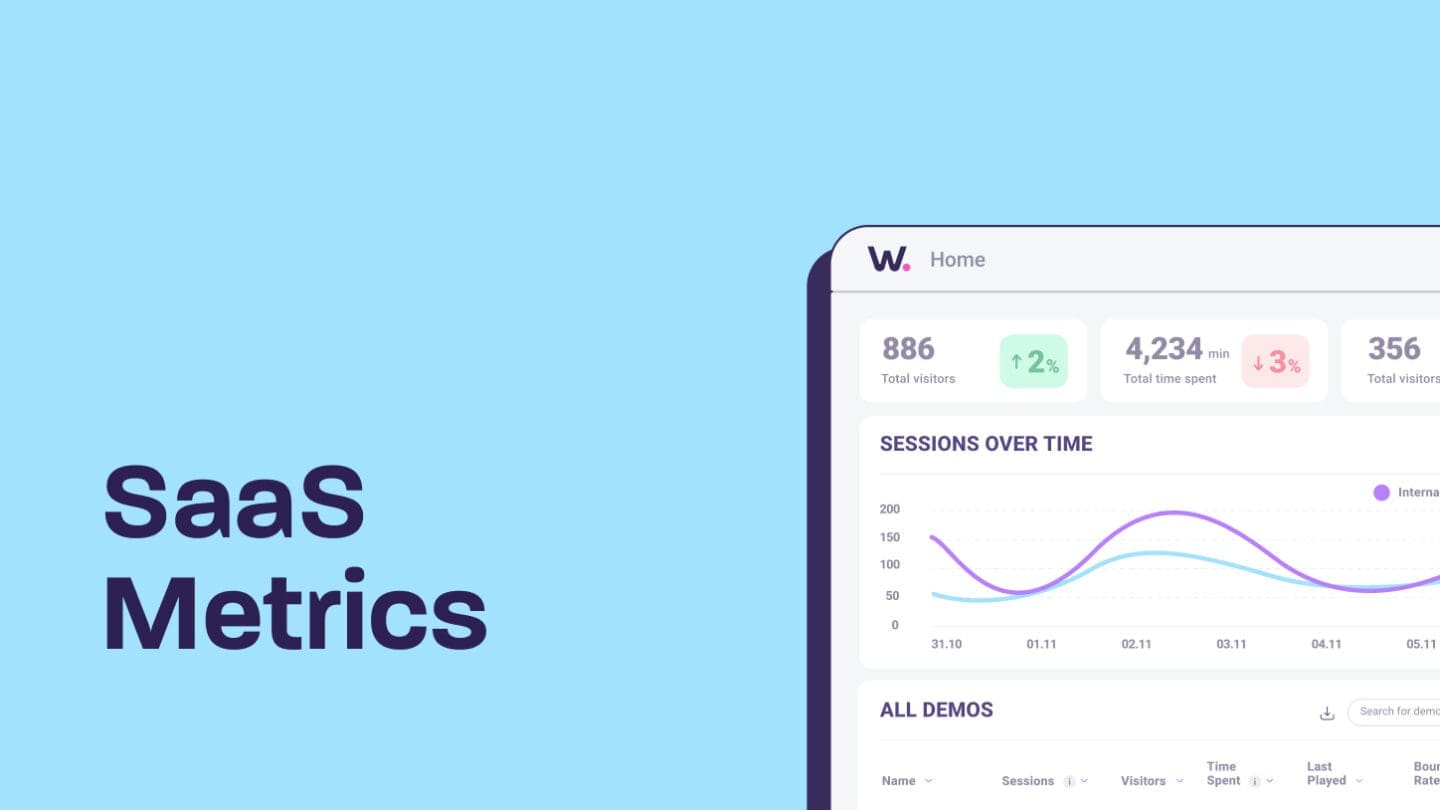These days, it feels like every company and their mother are pulling out all the glitz and glamor to present their products to prospects.
Don’t get us wrong. How you present your product is important. But it’s about how you do it.
2024 is the year to delve into interactive product tours to ramp up the power of your sales and customer engagement strategies. By offering unparalleled insights into products with just a click, you can take a more memorable and impactful approach to your lead nurturing strategy.
Because let’s face it, as a collective, our attention spans are increasingly fleeting. Interactive product tours stand out by providing detailed sales demonstrations that uniquely speak to each user in a manner that not only informs them on the value of your product, but will also engage them.
With the right approach, an interactive product tour can transform the user experience, leading to higher engagement, improved understanding, and ultimately, delighted customers.
So, join us as we break down everything you need to know about creating the best interactive product tour.
- Understanding your audience
- Setting clear objectives
- Research and competitive analysis
- Analytics and iterative improvements
- Storyboarding
- Interactive elements and features
- Content creation guidelines
- User testing and feedback
- Optimizing for mobile devices
- Promotion and distribution
- Choosing the right platform
- Using interactive product tours to build a winning B2B sales strategy
Create interactive product tours today with Walnut >
Understanding your audience
Creating the best interactive product tours requires having a deep understanding of your target audience and their respective journeys.
If you haven’t already defined your user personas, now is the time to do so. This will allow you to tailor the live sales demo experience to meet their specific preferences and needs by considering factors such as demographics, behaviors, and goals.
Personalization is key here, as it’s the ultimate way to show your prospects you care for them and their needs.
In addition, by segmenting your product tours based on user roles or behaviors, you create a more relevant and engaging experience that’ll increase the likelihood of them saying “yes.”
However, while working on your product tour, remember that your audience has varying degrees of comfort with technology. So, be sure to stick to the essential features of your product that present the most value to prospects, while also leaning on building confidence and trust.
Setting clear objectives
If you start creating an interactive product tour without clear objectives, that’s pretty much like winging a series of paid ad campaigns without any form of strategy set in place.
It’s crucial to start off with a firm grasp of your goals—whether it’s elevating feature adoption, boosting user engagement, or streamlining the onboarding process.
Setting such objectives will shape the structure of your product tour, and also ensure that every element introduced is purposeful and impactful for your audience.
It’s also important to delve deep into competitive analysis to understand how your peers introduce themselves to users. This step is crucial in identifying your unique selling points and differentiating your product tour in a crowded market.
Pay close attention to how competitors highlight key features, sequence their information, and guide users through the buying journey. Adopting best practices while infusing your product tour with innovative elements that reflect your product’s unique value proposition can set you apart.
Visualizing the end goal for your users is paramount. Your product tour should not only acquaint users with the product’s features, but also inspire confidence in its utility.
By mapping out a user journey that is logical, intuitive, and aligned with your defined objectives, you create a coherent narrative that incrementally builds the user’s understanding and skills. Every step of the tour should be a stepping stone towards enabling users to fully harness the power of your product, ensuring a seamless transition from curious buyer to proficient user.
Research and competitive analysis
Diving into the creation of an interactive product tour demands thorough market research and competitive analysis.
But what we’re referring to here is the analysis of competing product tours. The purpose isn’t to copy what everyone else is doing.
Rather, it is to understand your competition’s approach while also uncovering opportunities to innovate and stand out from the rest of the pack. This will allow you to grasp the prevailing trends, identify what resonates with users, and pinpoint areas that you know you can easily improve on.
This form of competitive analysis is instrumental in highlighting your product’s unique selling points, as it provides a clear landscape of how competitors communicate their value proposition and engage with their audience.
Embracing best practices in market research and competitive analysis ensures your product tour is not just another drop in the digital ocean, but a beacon that guides users effectively towards realizing the unique value your product delivers. Through this lens, every aspect of your product tour becomes a strategic move to elevate your product’s visibility and appeal in a crowded marketplace.
Analytics and iterative improvements
When it comes to perfecting an interactive product tour, the journey is continuous, and it is underscored by the powerful role of analytics and performance tracking.
Your initial demo won’t be perfect, but it will serve as a starting point, and its real value will lie in leveraging data for ongoing refinement.
Analytics are a lifesaver because they offer insights into how users interact with your product tour, while also pinpointing areas of engagement, and identifying stages where improvements may be needed.
Your team will need to be open for continuous improvement by closely monitoring performance metrics. This will allow you to adjust and optimize each element of the tour to better meet user needs and expectations.
This process is not about seeking perfection on the first attempt, but rather about being responsive and adaptable, using real-time feedback to incrementally enhance the user experience.
Storyboarding
To build an effective product tour, you’re also going to need to rely on storyboarding.
Storyboarding refers to visually organizing your interactive product tour, to ensure your message is conveyed with clarity and impact.
At the heart of effective storyboarding is the flow design. This helps in setting the stage for a compelling narrative that guides users through your product’s features and benefits. This process begins with defining the flow of your product tour, a task that requires a thoughtful balance between your objectives and the needs of your users.
The flow needs to lead users on a journey that progressively builds their understanding and engagement with your product, with each step of the tour meticulously designed to contribute to a cohesive story.
Visual elements play a crucial role in enhancing the overall experience. Imagine taking users by the hand, leading them through your product’s landscape where every feature and benefit is a scenic stop. This journey is thoughtfully plotted to deepen their understanding and investment in what you’re showing them. And here, visuals aren’t just decor; they’re powerful tools that grab attention and make a lasting impression.
When tailoring each step of the tour, it’s about viewing it through the user’s eyes—acknowledging the diversity in their backgrounds and challenges, and customizing the content accordingly. Adding interactivity turns the tour from a monologue into a dialogue, boosting engagement.
But the storyboard isn’t set in stone. It evolves through user feedback, a critical step where your product tour undergoes continuous refinement. This feedback loop is your product tour’s lifeline, ensuring it stays relevant and resonates deeply with your audience.
Through this process of ongoing enhancement, informed by user insights and analytics, your product tour doesn’t just keep pace with expectations—it sets new standards.
Interactive elements and features
Integrating interactive features and elements into your product tour transforms it from a passive presentation to an engaging journey.
These kinds of engagement tools are much like hosting a lively party where every element sparks interest and makes guests feel right at home. Variety is key, with each UI pattern bringing its unique flair to the event for user interaction.
Interactive tours serve as personal guides, leading users step-by-step through your product, simplifying complex processes into manageable chunks. Hotspots, the subtle nudges within your app, draw attention to specific points of interest, encouraging discovery and exploration.
Tooltips provide bite-sized pieces of information without demanding action, enhancing understanding with minimal intrusion.
Together, it all helps create an immersive experience that not only educates but also engages, ensuring your software makes a lasting impression.
Content creation guidelines
Content creation for interactive product tours requires a blend of engagement and education, aiming to capture the attention of today’s software buyers who prefer experiencing products directly over hearing sales pitches.
The core of a standout product tour lies in delivering content that is not only rich in information and visually captivating, but also clearly demonstrates your product’s benefits and value.
The ultimate aim is to connect your product with its potential users in a way that not only educates and engages, but also streamlines the path to conversion and onboarding.
By embracing these guidelines for content creation—prioritizing a design that speaks to users, ensuring interactivity, and maintaining clarity in your messaging—you lay the groundwork for a product tour that resonates deeply with viewers
And this will enrich their experience with your product from the first click.
User testing and feedback
Conducting user testing is a critical step in validating the effectiveness of your interactive product tour.
It offers a direct line to understanding how real users interact with your product tour, what they find engaging, and where they may encounter confusion or barriers. This process is not a one-off event, but rather an ongoing cycle of feedback loops and iteration, essential for refining and optimizing the tour experience.
Interactive tours provide opportunities for collecting user feedback, not limited to direct inquiries like surveys. Advanced analytics from interactive demo platforms can reveal detailed engagement metrics, highlighting which aspects of your product tour captivate users’ attention the most. This data simplifies the task of identifying strengths and pinpointing areas needing improvement for lead nurturing.
Embracing a continuous improvement mindset is vital. While gathering, analyzing, and acting upon user feedback can seem daunting, leveraging solutions with robust analytics capabilities can streamline this process. These insights allow for targeted enhancements, ensuring that every iteration of your product tour resonates more effectively with your audience.
It is worth noting that navigating through varied user opinions to make meaningful improvements can be challenging. It’s sometimes necessary to create customized versions of your product tour to cater to distinct user segments, ensuring relevance and effectiveness across diverse audiences.
Additionally, users can inadvertently help detect bugs or technical issues. Addressing these promptly enhances the tour’s reliability, ensuring a seamless experience. Utilizing tools that separate the demo environment from your product’s back-end can safeguard against exposing users to any technical glitches, maintaining the integrity of the user experience.
Through this iterative process of testing, feedback collection, and refinement, you can continually enhance your interactive product tour, making it an ever-more powerful tool in your engagement and conversion arsenal.
Optimizing for mobile devices
These days, optimizing your interactive product tour for mobile devices isn’t just ‘nice-to-have.’
If anything it’s a necessity. That being said, you need to ensure your product tour delivers a friction-free experience across various screen sizes and operating systems with responsive design.
This will also ensure cross-device compatibility. With all the tech that’s available, there’s no excuse for not being able to provide customer delight.
Mobile optimization enhances user engagement and accessibility on any internet-connected smart device, whether it’s a smartphone, tablet, or desktop, making it easier for potential customers to explore your product anywhere and at any time.
Promotion and distribution
There are many marketing tactics that can maximize the visibility and impact of your product tour.
It’s highly recommended to go beyond social media promotions and enforce a multi-channel approach to reach your target audience. Email campaigns, tailored to highlight the value and uniqueness of your product, can spark interest and encourage clicks from those already interested in your offering.
Forming partnerships with related businesses or platforms can further extend your reach, introducing your product to new but relevant audiences.
By strategically leveraging these promotion strategies and distribution channels, you can significantly increase the engagement and effectiveness of your product tour, turning viewers into users and advocates.
Choosing the right platform
When it comes to selecting the right platform for interactive product tours, you wouldn’t just want to choose randomly from the first page of your Google results.
This is a very important decision that can significantly impact your product tours’ effectiveness.
Beyond having a smooth UX, you want to make sure your platform of choice offers in-depth analytics. This will enable you to gauge how buyers interact with your tour, which is invaluable for ongoing refinement.
At the end of the day, a platform that offers robust analytics, flexibility in creating diverse tours, and supports your promotional strategies will be key to maximizing the impact of your interactive product tours.
You know, like Walnut (wink, wink).
Using interactive product tours to build a winning B2B sales strategy
Creating an effective interactive product tour in 2024 has become a core requirement for engaging and converting tech-savvy users.
This journey starts with understanding your audience, crafting a compelling narrative through storyboarding, and integrating interactive elements to create an engaging user experience.
Additionally you wouldn’t want to forget the importance of optimizing for mobile devices, utilizing effective promotion and distribution strategies, and choosing the right platform are crucial steps towards ensuring your product tour reaches its full potential.
Strategically implementing these guidelines will not only enhance your product’s visibility, but also significantly improve your user engagement and conversion rates.
What are you waiting for? Start creating winning interactive product tours by clicking that “Get Started” button.



